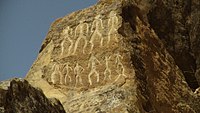Qara Qoyunlu: Difference between revisions
see discussion |
No edit summary |
||
| Line 1: | Line 1: | ||
[[Image:Karakoyunlular devleti.PNG|thumb|right|right|175px| Flag of the Kara Koyunlu]] |
[[Image:Karakoyunlular devleti.PNG|thumb|right|right|175px| Flag of the Kara Koyunlu]] |
||
{{History of Armenia}} |
|||
{{History of Azerbaijan}} |
{{History of Azerbaijan}} |
||
{{History of Iran}} |
{{History of Iran}} |
||
{{For|the district in Turkey|Karakoyunlu}} |
{{For|the district in Turkey|Karakoyunlu}} |
||
The '''Kara Koyunlu''' or '''Qara Qoyunlu''', also called the '''Black Sheep Turkomans''' ([[Turkmen language|Turkmen]]: ''Garagoýunly''; [[Azerbaijani language|Azeri]]: ''Qaraqoyunlu''; [[Turkish Language|Turkish]]: ''Karakoyunlu''; {{PerB|قراقویونلو}}), were a tribal [[federation]] of [[Oghuz Turks|Turkoman]] origin that ruled |
The '''Kara Koyunlu''' or '''Qara Qoyunlu''', also called the '''Black Sheep Turkomans''' ([[Turkmen language|Turkmen]]: ''Garagoýunly''; [[Azerbaijani language|Azeri]]: ''Qaraqoyunlu''; [[Turkish Language|Turkish]]: ''Karakoyunlu''; {{PerB|قراقویونلو}}), were a tribal [[federation]] of [[Oghuz Turks|Turkoman]] origin that ruled n what is today [[Eastern Anatolia|eastern Turkey]], [[Armenia]], [[Iranian Azerbaijan|north-western Iran]], [[Azerbaijan|Republic of Azerbaijan]], and northern [[Iraq]] from [[1375]] to [[1468]]. |
||
The Black Sheep Turkomans at one point established their capital in [[Herat]] in eastern Persia <ref>[[Patrick Clawson]]. ''Eternal Iran''. Palgrave Macmillan. 2005 ISBN 1-4039-6276-6 p.23</ref>, and were [[vassal]]s of the [[Jalayirid]] [[dynasty]] in [[Baghdad]] and [[Tabriz]] from about [[1375]], when the leader of their leading tribe, ruled over [[Mosul]]. However, the Turkomans rebelled against the Jalayirids, and secured their independence from the dynasty with the conquest of Tabriz by [[Qara Yusuf]]. |
The Black Sheep Turkomans at one point established their capital in [[Herat]] in eastern Persia <ref>[[Patrick Clawson]]. ''Eternal Iran''. Palgrave Macmillan. 2005 ISBN 1-4039-6276-6 p.23</ref>, and were [[vassal]]s of the [[Jalayirid]] [[dynasty]] in [[Baghdad]] and [[Tabriz]] from about [[1375]], when the leader of their leading tribe, ruled over [[Mosul]]. However, the Turkomans rebelled against the Jalayirids, and secured their independence from the dynasty with the conquest of Tabriz by [[Qara Yusuf]]. |
||
Revision as of 23:35, 18 July 2007

| History of Armenia |
|---|
 |
| Timeline • Origins • Etymology |
| History of Azerbaijan |
|---|
 |
|
|
| History of Iran |
|---|
 |
|
Timeline |
The Kara Koyunlu or Qara Qoyunlu, also called the Black Sheep Turkomans (Turkmen: Garagoýunly; Azeri: Qaraqoyunlu; Turkish: Karakoyunlu; Template:PerB), were a tribal federation of Turkoman origin that ruled n what is today eastern Turkey, Armenia, north-western Iran, Republic of Azerbaijan, and northern Iraq from 1375 to 1468.
The Black Sheep Turkomans at one point established their capital in Herat in eastern Persia [1], and were vassals of the Jalayirid dynasty in Baghdad and Tabriz from about 1375, when the leader of their leading tribe, ruled over Mosul. However, the Turkomans rebelled against the Jalayirids, and secured their independence from the dynasty with the conquest of Tabriz by Qara Yusuf.
However, in 1400, the armies of Tamerlane defeated the Black Sheep Turkomans, and Kara Yusuf fled to Egypt and sought refuge with the Mamluks. He gathered an army and by 1406 had taken back Tabriz.
In 1410, the Black Sheep Turkomans took Baghdad. The installation of a subsidiary Black Sheep Turkomans line there hastened the downfall of the Jalayirids whom they had once served. Despite internal fighting amongst Kara Yusuf's descendants after his death in 1420, and the increasing threat of the Timurids, the Black Sheep Turkomans maintained a strong grip over the areas they controlled.
Jahān Shāh made peace with the Timurid Shāh Rukh Mirzā, however, this soon fell apart. When Shāh Rukh died in 1447, the Black Sheep Turkomans annexed portions of Iraq and the eastern coast of the Arabian Peninsula, as well as Timurid controlled western Iran.
Though much territory was gained during his rule, Jahān Shāh's reign was troubled by his rebellious sons and the almost autonomous rulers of Baghdad, whom he expelled in 1464.
In 1466, Jahān Shāh attempted to take Diyar Bakr from the White Sheep Turkomans, however, this was a catastrophic failure resulting on Jahān Shāh's death and the collapse of the Black Sheep Turkoman's control in the Middle East. By 1468, the White Sheep Turkomans had swept away the last vestiges of the Black Sheep Turkomans.
References
- ^ Patrick Clawson. Eternal Iran. Palgrave Macmillan. 2005 ISBN 1-4039-6276-6 p.23
See also
Sources
- Bosworth, Clifford. The New Islamic Dynasties, 1996.
- Morby, John. The Oxford Dynasties of the World, 2002.
